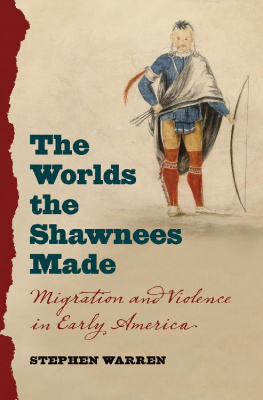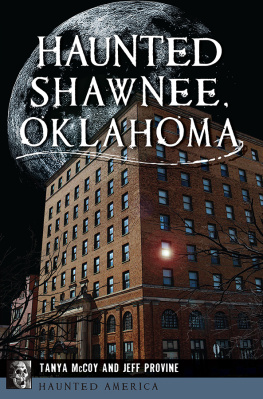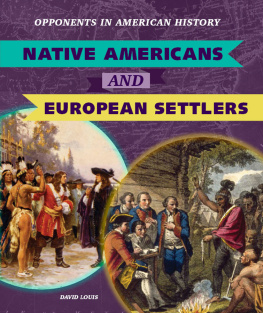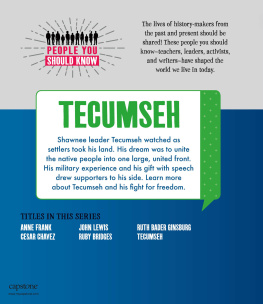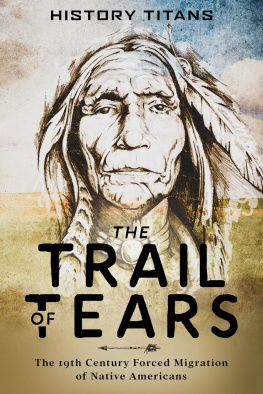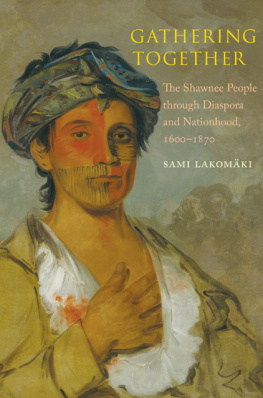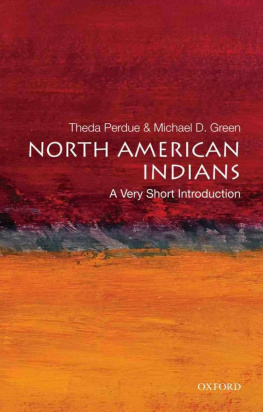The Worlds the Shawnees Made
This book was published with the assistance of the Anniversary Fund of the University of North Carolina Press.
2014 The University of North Carolina Press
All rights reserved
Set in Miller by codeMantra
Manufactured in the United States of America
The paper in this book meets the guidelines for permanence and durability of the Committee on Production Guidelines for Book Longevity of the Council on Library Resources. The University of North Carolina Press has been a member of the Green Press Initiative since 2003.
Library of Congress Cataloging-in-Publication Data
Warren, Stephen.
The worlds the Shawnees made : migration and violence in early America / Stephen Warren.
pages cm.
Includes bibliographical references and index.
ISBN 978-1-4696-1173-0 (hardback)
ISBN 978-1-4696-1174-7 (ebook)
1. Shawnee IndiansHistory. 2. Shawnee IndiansMigrations. 3. Shawnee IndiansWars. I. Title.
E 99. S 35 W 375 2013
974.00497317dc23
2013029967
18 17 16 15 14 5 4 3 2 1
for Kristy
Contents
Maps and Illustrations
Maps
The Boundaries of the Fort Ancient World,
Fort Ancient Traded Goods,
Warrior Paths,
Chesapeake and Lancaster County Indians,
Chartiers Journey,
Illustrations
Viola Dushane,
Barred pendant,
Late Fort Ancient village,
Shell maskette,
Disk pipe,
Cordmarked jar,
Slave halter,
Philip Georg Friedrich von Reck, Indians going a hunting,
Philip Georg Friedrich von Reck, A War Dance,
Philip Georg Friedrich von Reck, The Indian King and Queen of Uchi,
Acknowledgments
Books, like people, have histories. And this book, in particular, is inextricably tied to T. Randolph Noe. A probate lawyer living in Louisville, Kentucky, Randy collected documents related to Shawnee history for more than a decade. His love of Shawnee history compelled him to travel vast distances, at his own expense, in search of everything that had ever been published about the Shawnee people. When Randy passed away in 2003, he left behind a published bibliography and a vast archive that continues to live among Shawnee people, who have used the knowledge contained within it to create maps, grant projects, and many other efforts related to the preservation of their remarkable history.
Randy and I got to know each other in 2000, when my partner, Kristy, and I were living in Berea, Kentucky. We met several times to discuss our shared love of Shawnee history. We even managed to travel to the War Dance at the North Ceremonial Ground, in Little Axe, Oklahoma. Most historians work in private, mulling over the small details of big projects for years on end. Randy helped me to realize that the closed loop that I maintained in my mind could, in fact, be shared. We talked for hours on end about Shawnee history and began to share our documents and our knowledge with members of the federally recognized Shawnee tribes. Randy became that rare person who could and would discuss the particulars of troubling documents, the hard-to-discover villages, and the seeming non sequiturs that represent the printed knowledge of Shawnee history. When cancer claimed him, we all lost a raconteur whose generosity is rare indeed.
Kristy and I then moved to Rock Island, Illinois, to teach at Augustana College. Randys kids thus had to drive his archive from Kentucky to Illinois, and I am grateful for the trouble they went through. With twenty-four banker-boxes of material, I struggled to find room to house it all. But the real challenge lay in the fact that this treasure trove of material arrived the night before our first child, Cormac, arrived in this world. Kristy remained, as always, more composed than I was amid the shuffling of boxes and the final adjustments to our foolproof birth plan. Miraculously, we all survived the ordeal, as the singer John Prine has sung, in spite of ourselves. By 2005, Kristy and I had published our first books. The richness of our shared life together has only been increased by the arrival of Declan in 2006 and Josie in 2009. Our children have had to share in our professional journey, quite literally, from the beginning. But they have grown to appreciate the opportunities research presents. Cormac even had the audacity to break from vegetarianism and eat his first cheeseburger in Norman, Oklahoma, while I was on a research trip.
Since that fall night a decade ago, I have shared Randys collection with members of the three federally recognized Shawnee tribes. Working with cultural preservation officers and Augustana students, we created a national map of Shawnee locations. We unveiled the map in 2005, and Shawnee people marveled in amazement at the depth and breadth of their travels across North America. For tribes such as the Shawneesforced from their Ohio homeland into Indian Territory, what is now Oklahomathe map and the documents have become a kind of repatriation of cultural and historical knowledge. Contemporary Shawnees know a thing or two about resilience, and the map seemed to confirm that this trait has stayed with the Shawnee people since colonizers arrived and reordered the natural and cultural worlds to which they were accustomed. At least initially, archival research became the means by which I have been able to participate in an extended conversation with many Shawnee people, who have worked tirelessly to maintain their culture and to recover what has been lost. Randys archive has become a never-ending gift, as more and more Shawnee people have shared in the knowledge it contains.
Books derive as much from the authors who write them as from the editors who acquire and improve them. I did not begin researching this project in earnest until 2008, when Robbie Ethridge asked me to contribute a chapter to her book, co-edited with Sheri Shuck-Hall, Mapping the Shatter Zone: The Colonial Indian Slave Trade and Regional Instability in the American South. Robbie saw the potential in this project well before I did, and I am very grateful to her for being such a thoughtful editor. Robbie introduced me to Mark Simpson-Vos at the University of North Carolina Press. Mark has also refused to settle for my initial attempts to make sense of violence and migration in Shawnee and colonial-era Woodland Indian histories. At the time I agonized over the rigor of Robbie and Mark. But in hindsight, I am certain that their suggestions have improved this work. Finally, my toughest editor has been my brother, Michael Warren. He line-edited parts of this book as only a news editor for the Associated Press can. Sibling rivalries aside, I will be the first to admit that he is the superior writer, and I cannot imagine where I would be without his help over the years. Time and distance have separated us, but Mike has remained a dear friend.
A curious mixture of hubris and humility is essential to writing nonfiction. It takes hubris because a fragmented primary source record confronts us at every turn, and the silences within and between the sources frustrate our attempts to unlock past worlds. And yet I have pressed on and told a story composed out of tantalizing, but incomplete, shards of evidence. In response to such an incomplete record, I have asked for a lot of help over the years. Anthropologists and archaeologists who have provided essential guidance include Jason Baird Jackson, A. Gwynn Henderson, David Pollack, Jessica Walker Blanchard, Robert Cook, and Tom Whitley. I am also grateful to Penelope Drooker, Cheryl Ann Munson, James Morton, Tracy Brown, Brice Obermeyer, Charlie Cobb, and Gregory Waselkov for their willingness to point me in the right direction through well-timed, corrective emails and comments on papers. Among historians, I have learned a lot from Colin Calloway, R. David Edmunds, Donald Fixico, Gregory Evans Dowd, Thomas Appleton Jr., Tracy Leavelle, Josh Piker, and Alan Shackelford. Experts on material culture, including David Penney, R. Scott Stephenson, Buck Woodard, Carolyn Gilman, Adriana Greci Green, and Alan Gutchess, have greatly improved my capacity to integrate material culture into my understanding of the written and ethnographic records.
Next page
